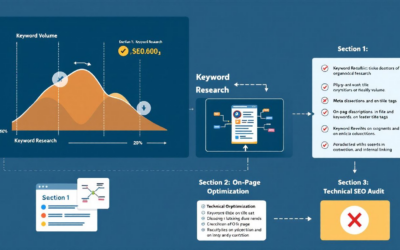Website traffic down? You may be wondering why is my website traffic dropping. Various factors, like algorithm updates or technical issues, could be the culprits. This article will help you pinpoint the causes and find viable solutions.
Key Takeaways
-
First, confirm if there’s a genuine decline in traffic using tools like Google Analytics before jumping to fixes.
-
Stay updated on Google algorithm changes as they can significantly impact your website’s rankings and traffic.
-
Regularly monitor your site’s technical SEO, content quality, and backlinks to avoid traffic drops and maintain visibility.
Identifying the Source of Traffic Drops

Before taking action to remedy a sudden drop in website traffic, it’s crucial to confirm that the decrease is real. Jumping into solutions without this verification could lead you to tackle nonexistent problems due to temporary fluctuations or seasonal variations in traffic.
Leverage Google Analytics for an accurate analysis of which specific landing pages are experiencing a loss of traffic. This powerful tool aids in discerning where referral traffic drops originate from and can even reveal if the issue stems from individual pages disappearing from search indexes. Use Google Search Console alongside Google Analytics to investigate the reasons behind a traffic drop and develop effective recovery strategies.
A variety of factors might be at play when dealing with traffic drops such as updates to search engine algorithms, imposed manual actions, or glitches within technical SEO practices. It is vital to determine the fundamental cause behind these dips – whether they result from shifts in user behavior, dwindling referral sources, or underlying SEO challenges.
In your digital marketing efforts, use tools designed for tracking changes in keyword rankings and spot notable downturns promptly. After noticing any decline in web traffic, scrutinize your site’s technical setup for recent modifications that may have contributed to this issue.
Impact of Google Algorithm Updates
The notorious Google algorithm updates frequently lead to significant changes in search engine rankings. Sudden and unexplained drops in organic website traffic, often referred to as ‘lost traffic’, can occur due to these algorithm updates. It’s a common experience for webmasters and SEO professionals alike: one day your website enjoys high visibility, and the next it’s submerged deep within search results. Understanding these updates is key to recovering any lost positioning.
Updates such as the Reviews Update in April 2023 and the Core Update in August 2023 were implemented with the intent of refining the quality of google search results. The introduction of the Topic Authority System in May 2023 highlighted how crucial content relevance and reputation are, while September’s Helpful Content System update focused on prioritizing content that serves users well over purely SEO-driven text.
In October 2023, another Core Update fine-tuned major ranking mechanisms Pushing towards better content quality standards and enhancing user experiences online. This followed through into November when yet another Reviews Update sought to raise review-content standards across searches.
Utilization of tools like Google Search Console becomes indispensable during such times for monitoring keyword effectiveness as well as tracking shifts within organic traffic patterns post-update. Third-party services including Mozcast, SEMrush Sensor, or Algoroo can also be invaluable resources for detecting variations due to adjustments made by these algorithmic refinements.
Ensuring regular evaluation—and consequently adaptation—of your SEO strategies remains crucial amidst frequent alterations caused by updates to Google’s algorithms. This way you’re more likely to stay ahead, ensuring stable search engine standings.
Checking for Manual Actions in Google Search Console
If you experience an unexpected drop in traffic, manual actions could be to blame. These penalties are applied by human reviewers when a site breaches Google’s spam guidelines and can result in your site being excluded from Google search results.
To investigate whether manual actions have been taken against your website, refer to the Manual Actions report within the Google Search Console. This feature will detail both the number of manual actions enacted on your site as well as specify which pages are implicated.
Upon discovering any manual actions listed in this report, you must address the issues on each impacted page. After rectifying these problems, submit a request for review through the Search Console to restore your position within Google’s search visibility.
Analyzing Technical SEO Issues

Issues with technical SEO, including broken links, slow page loading times, and suboptimal design, can diminish your website traffic as user experiences deteriorate leading to high bounce rates which in turn affect search engine rankings. Even seemingly minor technical problems have the potential to cause substantial reductions in web traffic.
To begin addressing these issues, assess elements like broken links, crawl errors, and site speed delays. Utilize resources such as Google Search Console or SEMrush for insights into these areas. For an extensive review of your website’s health concerning broken links on individual pages, employ tools like Ahrefs’ SEO toolbar.
Adopting HTTPS along with SSL certificates is essential not only for maintaining robust security, but also for enhancing search engine rankings. Carrying out periodic checks for replicated content is vital in avoiding indexing complications by search engines. Creating a coherent structure within your site will assist both crawling and indexing efforts by search engines effectively. Correct any dysfunctional internal connections promptly and verify that crawlers are able to index all parts of your website without impediments.
Content Quality and Relevance

Quality content reigns supreme, but it must be current and of high caliber. Content that is not up-to-date or of poor quality can impede your website’s development and diminish its visibility on search engines. As time passes, such outdated material tends to decline in rankings and attract less traffic.
To maintain the freshness and appeal of your content, it’s important to routinely update it while steering clear of excessive use of keywords, a practice known as keyword stuffing. Producing content that is both relevant and high-quality entices users to spend more time on your webpage. Recognizing which types of content resonate best with audiences for certain keywords should steer the direction for devising your strategy for creating new materials.
Incorporating a variety of content forms like videos and infographics acknowledges different preferences among users, thereby enriching their experience. By examining what competitors are doing right or wrong in terms, strategy may uncover overlooked valuable keyword opportunities for you to exploit. Spotting deficiencies within their approaches could provide insights into novel ideas for crafting superior contents that will eclipse theirs in performance.
Competitor Analysis
Examining the SEO and marketing tactics of your competitors can uncover where they might be excelling beyond you. By searching for your main keywords, evaluate whether their performance is impacting your web traffic. A strong competitor presence could slash your traffic by half if you fall behind in rankings. Delving into what rivals are doing can shed light on variations in web traffic and standings. Top-notch content may boost click-through rates and lead to a rise in backlinks.
Scrutinizing the backlinks of competitors may uncover opportunities through broken links that could help you gain new ones. Keep an eye on the competitive strategies regularly, allowing for swift adaptation to any changes within the market dynamics. If competitors have gained an upper hand with regards to SEO results, it’s worth considering producing superior content or crafting targeted web pages specifically designed to improve performance.
Monitoring Backlinks
Backlinks are crucial for your website’s authority. Regular monitoring is essential because broken links can emerge from your site and changes in the referring domain. A single lost backlink can cause a noticeable drop in traffic.
Tools like Google Search Console provide basic reports on domains linking to your site, aiding in backlink monitoring. Ahrefs and Semrush allow for detailed examination of page authority and monitoring of new or lost links. Analyzing competitors’ link profiles can uncover opportunities to improve your own backlink acquisition efforts.
Backlinks can lose value if the hosting website undergoes ownership changes, altering its content focus. Regularly check for broken or lost backlinks and fix them to maintain your web traffic.
Seasonal and Trend Changes

Variations in the seasons and prevailing trends profoundly influence website traffic patterns and how users behave. For example, businesses related to gardening and outdoor pursuits often experience a surge in web traffic during spring, whereas summer tends to bring a slowdown with families turning their attention towards holidays.
Utilizing Google Trends is beneficial for discerning the search interest fluctuations of particular keywords over different periods. By grasping these trends, you can tailor your content strategy accordingly, which helps maintain consistent levels of search traffic by adapting to seasonal shifts and evolving trends.
Tracking Code Errors
It is essential to confirm that your tracking code is intact and operating accurately to maintain precise records of traffic data. If you notice sessions are not registering, this could signal errors with the tracking codes, which may have been inadvertently deleted or misconfigured, causing a considerable decrease in logged traffic.
To guarantee reliable data gathering through Google Analytics, make sure the tracking snippet has been correctly integrated into your website. Swiftly resolving any problems related to the tracking code is key for obtaining true measurements of how well your website is performing.
Summary
In summary, addressing a drop in website traffic involves several key steps: identifying the source, understanding algorithm impacts, checking for manual actions, analyzing technical SEO issues, and maintaining high content quality and relevance. Regular competitor analysis and backlink monitoring are also crucial, as are adapting to seasonal trends and ensuring accurate tracking code implementation.
By following these strategies, you can diagnose and reverse your traffic drops, keeping your website healthy and thriving. Take action today and watch your traffic bounce back stronger than ever.
Frequently Asked Questions
How can I confirm if my website traffic is genuinely dropping?
To determine whether there is an actual decline in your website traffic, simply examine the trend data for your landing pages within Google Analytics.
Should you observe a persistent downward trajectory, this should prompt a deeper investigation into the cause.
How do Google algorithm updates affect my website’s traffic?
Altering your search rankings, updates to the Google algorithm can significantly impact your website’s traffic.
To maintain a consistent flow of traffic, it is crucial to remain updated and modify your SEO strategy in response to these algorithm updates.
What are manual actions in Google Search Console?
Manual actions are penalties from Google when a reviewer spots spammy practices on your site. If you get hit with one, it could mean your site might not show up in search results anymore.
Why is technical SEO important for maintaining website traffic?
Because technical SEO ensures your website remains quick and easy to access, it contributes to reduced bounce rates and enhanced search engine rankings, thereby maintaining consistent traffic flow.
How can I leverage competitor analysis to improve my website’s traffic?
Certainly, investigate the SEO tactics employed by your rivals and take note of the keywords they focus on. By modifying your content accordingly, you can enhance your position in search rankings to attract additional traffic.









